There are thousands of varieties of cheese made each day across the world. A cheesemaker will start with a vat of milk and by the end of the cheesemaking process, cheese has been made. Also, if you make several different cheeses on the same day and use the same milk for each cheese, each cheese will turn out differently. These cheeses are all different but they are all coming from the one ingredient; milk?
The cheesemaker has many variables under their control, each of which will slightly or significantly influence the type of cheese being produced. When these variables are combined, that same milk can make a cheese that can be vastly different to another cheese.
One of the critical aspects in making good cheese is for the cheesemaker to understand the application of each of these variables and the resulting effect that will have on the finished cheese.
The variables include:
Variables in the manufacture of cheese varieties
Type of milk
Milk from different animals will impart different characteristics to a cheese. Some varieties are only considered genuine when made from the milk of a particular animal such as Roquefort made from ewe’s milk, Cheddar cheese made from cow’s milk, and Chabichou du Poitou from goat’s milk. Cow’s milk tends to impart a yellow colour to cheese.
Even milk from the same cow, but produced at a different part of the season, may produce different results in cheese. With the variations in milk composition, the cheesemaker may need to apply different techniques to make that same type of cheese. For example, Mozzarella from buffalo’s milk is made differently when cow’s milk is used. A Brie made from a cow’s milk that has just calved may be different to a Brie made with milk from the same cow 8 months later.

Standardisation of fat
In setting out to make any particular cheese variety, the resultant cheese will be different depending on the balance of fat to protein in the milk. The fat content can be adjusted by adding or removing cream. Lower cream levels will tend toward increased hardness of a variety, for example: Parmesan and Romano cheese. Increased cream levels will tend towards higher fat and higher moisture cheese, such as Triple Cream or Brie cheese.
Heat treatment of milk
The use of raw or pasteurised milk often divides the cheesemaking community. Raw or pasteurised milk can be used to produce any variety of cheese, however cheeses with protected designations of origin status (PDO) may stipulate that only raw milk may be used. Outside of those rules, the cheesemaker has to make a significant decision about the safety of the cheese, based partly on using either raw or pasteurised milk.
Curd from pasteurised milk may tend to be softer, due to precipitation of some of the soluble calcium, and it may be necessary to compensate by the addition of calcium chloride before renneting.
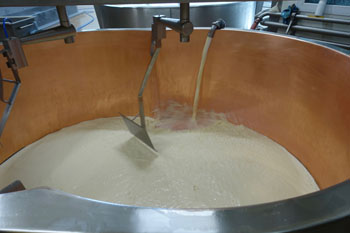
Homogenising
The disruption of fat globules caused by homogenising exposes a much greater surface area of fat to the action of the enzyme lipase, thereby accelerating the fat breakdown process during cheese maturing. Homogenising also makes a curd that is very fragile and that curd is prone to breaking into smaller pieces. On some occasions, the cream is separated from the milk, homogenised, and then added back to the milk. This provides conditions for extra fat breakdown (and greater flavour development) and a whiter-coloured cheese. This is desirable in some Blue Vein cheese.
Homogenising is also used for industrial cream cheeses, sour creams and yoghurts.
Degree of souring of milk
This may be controlled by varying the temperature of the milk and the volume and type of starter added, or by varying the time between the addition of starter culture and the addition of rennet. Some cheese, such as Cheddar, requires only a small amount of souring before the rennet is added, while some cheese such as certain blue vein varieties require more than one hour. Lactic acid curd, such as Persian Feta, requires several hours. High acidities will favour increased moisture expulsion and firmer curd.
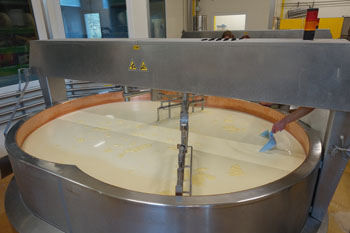
Lactic starter cultures
Starters are selected for different cheese varieties for three basic reasons: they must be able to produce a certain amount of acid over a certain time, they must also produce desirable flavours, and they must be able to withstand the temperatures that the curds and whey reach. Nearly all of the cheeses made across the world are either mesophilic or thermophilic cultures. Then each of those two broad categories has hundreds of different cultures to choose from. The Cultures Reference Chart explains some of those differences. Some cultures will come in a singular species of bacteria in one packet whereas other cultures will come with multiple species within one packet.
Some cheese varieties such as Ricotta, require no starter culture. The curd is formed by heating to around 90°C and adding an organic acid to complete the precipitation. The curd rises to the top and is ladled into perforated moulds for draining. It is then eaten fresh.
Flavouring and ripening cultures
These are the cultures that provide flavour and texture to your cheese but produce little or no acid. You usually see the work these cultures perform on the cheese once the cheese is hooped. These cultures are what make your Camembert white, Blue Vein blue, Washed Rind red and eyes associated with Gruyere and Emmental cheeses.
In large eye type cheesemaking (for example, Emmental), the starter comprises several different cultures because of the various stages of manufacture, to produce acid slowly during the early stage of manufacture, and then to withstand the high cooking temperature later in the process.
Amount and type of rennet used
Increased rennet dosage will tend to produce a firmer curd, with an increased rate of protein breakdown during maturing. Excess rennet may cause ‘bitterness’. Some cheese, such as Halloumi, does not usually require a starter culture but rennet is essential. Some cheeses, such as lactic acid varieties, require very minimal rennet, relying on the developed acidity to form the curd. Yoghurt will form a curd without the addition of any rennet.
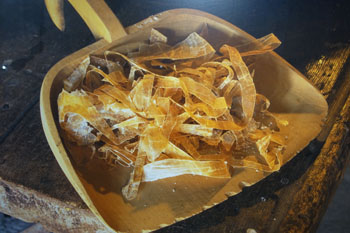
Size of cut
Fine cutting of the curd will favour increased moisture expulsion, resulting in a firmer cheese. Softer varieties, for example, Mozzarella, Blue Vein and Camembert cheese, frequently employ a larger cut to retain moisture.
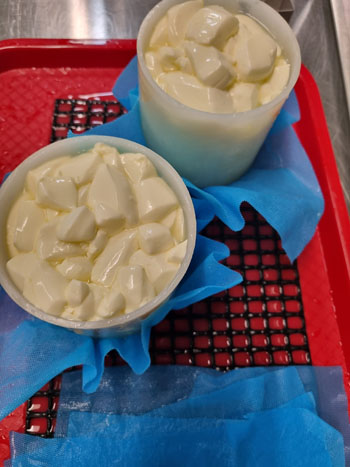
Temperature used in cooking
High cooking temperatures favour increased curd shrinkage to produce firm curd in the whey, and in some cases, to reduce the levels of undesirable bacteria. The use of heat-tolerant starters ensures that they survive the high cooking temperatures, and then acid production resumes later when the curds are cooled. Acid production usually continues during early maturing until the lactose has been fermented.
In some fresh, soft, or semi-hard types of cheese where high moisture content is desired (for example Blue Vein, Feta and Camembert) the curds and whey are not cooked.
Near boiling temperature is used for non‑cultured cheese where the curd is formed by heat precipitation of the albumin followed by sudden acidification to induce coagulation and flocculation of all the protein (for example, Ricotta).
In the manufacture of Edam, Gouda and Raclette styles, part of the whey is removed during or immediately after cooking, and replaced by pasteurised water, either at the same temperature as the milk or slightly hotter, in order to reach the final cooking temperature. The amounts of whey removed and the subsequent amount of water added can be varied and are used to vary the pH and body of the cheese.
The more water that is added, the longer the curd remains in the diluted whey, the higher the cheese’s pH will be (less acidic), and the weaker the body. The extra water in the whey surrounding the curd particles causes more lactic acid and lactose to diffuse out of the curd. This results in less residual lactose in the curd after whey removal, thereby limiting the extent of subsequent acid development, particularly after the curd is hooped.
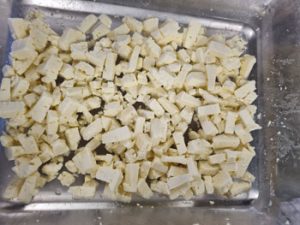 Degree of whey drainage
Degree of whey drainage
The stage and method of whey removal have important effects on the cheese produced. Early drainage of a soft curd is usually used in making soft cheese types. Some traditional Camembert only requires the ladling of coagulated curd directly into the moulds, with no cutting, stirring or cooking. Some Feta styles are placed in drainage hoops or trays as soon as the curd has been cut. Blue Vein requires a short period of agitation and curd firming before it is placed in perforated hoops for draining and matting.

Late draining after prolonged agitation, high cooking temperature and acid development characterise the making of most firm and hard cheese (for example, Cheddar, Parmesan).
For eye-type cheese, whey drainage is completed only after the curd has been compressed under the whey. This is necessary to achieve a close textured cheese with no mechanical openings due to the inclusion of air during drainage and pressing. Any mechanical openings in eye-type cheese will cause uneven and irregular eye formation, a serious appearance defect.
Bag draining without hooping and little or no pressing is applied to cheese with no real fused curd structure or shape. Cheese of this type includes Quark, Labneh and Cream cheese.
 Methods used to compact curd
Methods used to compact curd
Curd may be salted and pressed without any time allowed for matting (stirred‑curd type such as Colby) or allowed prolonged periods of matting (for example, Cheddar). Some varieties such as Edam and Gouda employ matting by pressure under the whey to give close textured cheese due to the complete exclusion of air.
Varieties such as Mozzarella and Pizza cheese incorporate vigorous dry or wet stretching of the matted curd (pasta‑filata process) to impart a smooth velvety character to the curd.
Firm cheese varieties employ mechanical pressure to finally mould the finished cheese, while softer varieties frequently rely on no application of pressure.
Method of salting
Salt, except in low concentrations, retards or stops bacterial growth, including that of starters, so it is always applied when acid production is sufficient and needs to be moderated. Salting from the outside, either by brining or dry salting after the cheese has been pressed, allows acid production, regulated by storage temperature, to continue inside the cheese for some time, as the salt only penetrates slowly.
Brine or dry salting aids in forming a rind by producing a dry salty zone around the outside of the cheese.
The salt content of cheese is controlled by the amount added, salt grain size, when it is added and the time of exposure during brining and by rubbing salt into the cheese. Some cheese (for example, Feta) are packed, stored, and marketed in brine.
 Conditions and length of curing
Conditions and length of curing
The object of curing is to allow the cheese to mature at a rate that results in the properly balanced development of flavour and other properties such as mould development and softening. Cost considerations generally mean that the fastest rate of maturing, which does not affect quality, is used.
Generally speaking, cheese with high moisture content and a delicate flavour require the shortest ripening period. Fresh cheeses such as Cottage and Quark are not ripened at all. Cheese like Camembert reaches and passes its peak of maturity after several weeks.
Curing times lengthen as moisture contents decrease. Romano cheese at six months of age is a moderately flavoured table cheese but can be cured for 12 or 24 months or more and used for grating and cooking.
Curing conditions for most natural rinded cheese varieties vary between 7°C‑14°C at 75% ‑ 80% relative humidity. The same cheese, if matured at 4°C, 8°C and 12°C will each produce different flavour outcomes. These conditions ensure the desired flavour development and prevent mould growth and drying out of cheese. Mould ripened and surface ripened varieties require high humidity (95%).
Use of special bacteria or mould in curing
Under this heading, there are several treatments that are peculiar to certain types of cheese, and contribute to their characteristics.
Internal mould ripening: In the various ‘blue’ cheese varieties, the growth of Penicillium roqueforti inside the cheese produces a characteristic spicy, peppery flavour, as well as a distinctive marbled colour. The flavour is a combination of the mould itself and various fat and protein breakdown products resulting from the actions of enzymes, produced either by the mould and the starter, or present in the milk. The mould may be added either to the milk before setting or to the curd after whey removal, or before hooping.
During storage, the cheese is usually pierced with thick stainless steel wires to admit air, which is essential for mould growth. The cheese should also have considerable mechanical openness to allow even mould growth throughout.
Surface ripening: The ripening of many types of soft or semi-hard cheese is aided by enzymes and flavouring substances produced by microorganisms growing on the surfaces.
The ways in which these surface growths are induced and controlled are varied, ranging from strictly controlled use of pure cultures to rather ‘natural’ arrangements in which many organisms grow either together or in succession during storage. The use of a high-humidity ripening cave with even temperatures, often with little or no air circulation, is usually necessary to obtain good surface growth.
Eye formation: Although Gruyere and Emmental are the best-known examples of eye-type cheese, there are many others that have smaller or fewer eyes; these include Tilsit, Havarti, Samsoe, Edam and Gouda cheese.
Successful eye formation depends on the inclusion of organisms in the starter such as propionic acid bacteria or Leuconostoc and Streptococcus diacetylactis strains. Correct temperatures of storage are also essential. Large eye types such as Gruyere are usually stored at a temperature around 20°C for several weeks, during which time eye formation occurs, causing the cheese to swell. When the eyes are the right size, the temperature must be reduced to around 10°C to stop the further enlargement of the eyes.
Use of additives
A number of herbs and spices are used in traditional cheese varieties. These are usually mixed with the curd just before hooping. Whole peppercorns are added to stirred Romano-type curd to make Pepato cheese. Leiden cheese is flavoured with added cumin seeds. Sage Derby cheese has ground sage mixed in with the milled curd. This not only flavours the cheese but also produces a pleasing green veining as each milled curd particle is outlined with a green edge. It is important to ensure any herbs or spice added to cheese has low bacterial numbers as failure to do so may result in cheese defects.
Enzymes such as lipase are added to varieties such as Feta, Parmesan, and Romano to accelerate the breakdown of fat and produce the required flavour.

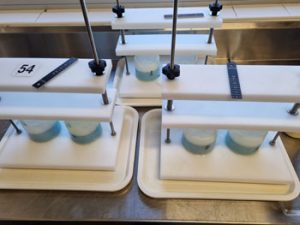 Methods used to compact curd
Methods used to compact curd Conditions and length of curing
Conditions and length of curing


